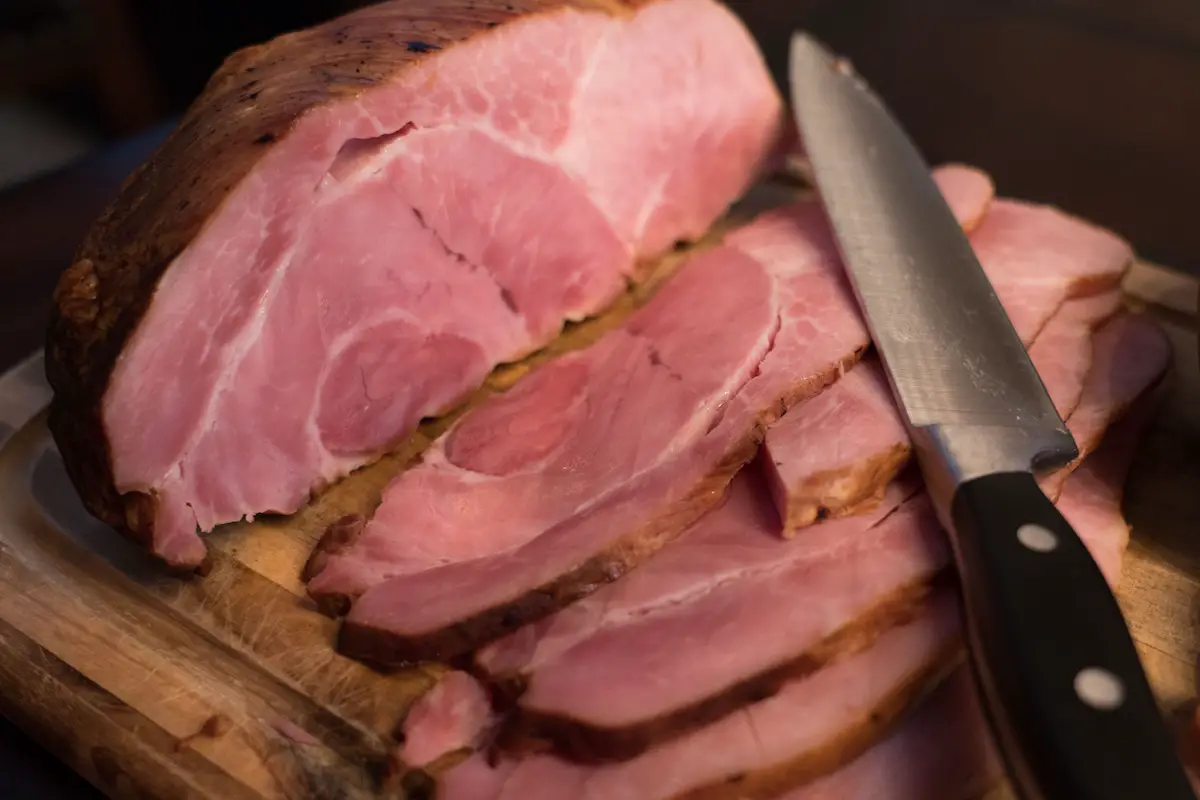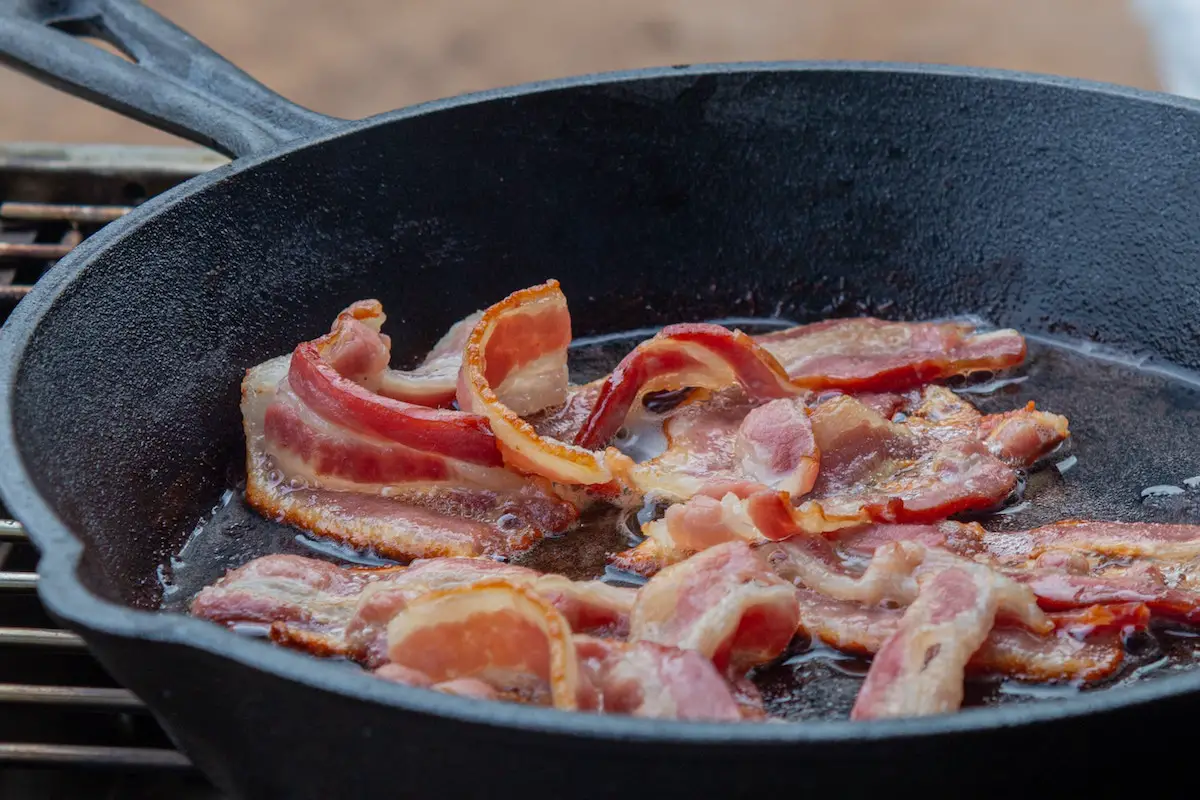Nominated-Day or Next-Day
Nominated-Day or Next-Day

Ham and bacon both are pork meats, but they are cut from different parts of the pig. Ham is typically cut from the hind leg of the pig, while bacon can come from various parts, such as the back, belly, or sides.
If you’re a meat lover, you’ve probably heard of ham and bacon. These two pork products are often used interchangeably, but they are quite different in terms of taste, texture, and preparation methods.
You will see different hams and bacons featured in our food hampers and charcuterie hampers.
Knowing the differences between ham and bacon can help you choose the right one for your recipe or meal.
Ham and bacon are both popular pork meats that are often used in a variety of dishes.
They are quite similar in many ways, but there are also some key differences between them that set them apart.
In this section, we will explore the differences between ham and bacon in terms of taste, texture, and cooking methods.
Ham and bacon have distinct flavors that are a result of their different preparation methods.
Ham is typically less salty and has a milder flavor than bacon. It has a slightly sweet taste and is often used in sandwiches or as a main dish.
Bacon, on the other hand, is known for its salty and smoky flavor. It is often used as a breakfast food or added to dishes for a burst of flavor.
There are other types of bacon, like Irish bacon, which have a very different taste in comparison to American bacons.
The texture of ham and bacon is also different. Ham is typically softer and less chewy than bacon.
It has a smoother texture and is often sliced thin. Bacon, on the other hand, is crispy and crunchy.
It has a chewy texture and is often served in strips or chopped up and added to dishes for texture.
Ham and bacon require different cooking methods. Ham can be cooked in a variety of ways, including baking, boiling, or grilling.
It can be served fresh or cured and is often sliced thin for sandwiches or cubed for use in casseroles or soups.
Bacon is typically fried or baked until crispy. It is often served as a breakfast food or added to dishes for flavor and texture.
In summary, while ham and bacon are both pork meats, they have distinct differences in terms of taste, texture, and cooking methods.
Ham is milder and softer, while bacon is salty, smoky, and crispy.
Both meats are versatile and can be used in a variety of dishes, depending on your preferences.
Ham is a type of meat that comes from the hind leg of a pig. It is a popular food item that can be found in many different forms and styles.
Ham can be eaten raw, but it is typically cooked before it is consumed.

There are many different types of ham available, each with its own unique flavor and texture. Some of the most popular types of ham include:
Ham can be used in a variety of different recipes, including sandwiches, salads, and casseroles.
It is a versatile ingredient that can be enjoyed in many different ways.

If you are a meat lover, you must have heard of bacon. Bacon is a type of cured meat that comes from the back, belly, or loin of a pig.
It is a popular breakfast food and is used in many dishes for its unique flavor. Here is everything you need to know about bacon.
There are different types of bacon available in the market, and each has its own unique taste and texture.
Here are some of the most popular types of bacon:
The way bacon is cut can affect its taste and texture.
Here are some of the most common cuts of bacon:
| Cut | Description |
|---|---|
| Rashers | Thinly sliced bacon that is popular in the UK and Ireland. |
| American Bacon | Thickly sliced bacon that is popular in the US. |
Regardless of the type or cut of bacon, it is usually cured and smoked to give it its distinctive flavor.
The shape and taste of bacon can vary depending on the type, cut, and preparation method.
Now that you know what bacon is and the different types and cuts available, you can choose the right bacon for your next meal.
When it comes to comparing ham and bacon, many people wonder which one is healthier.
Both ham and bacon are high in protein, but they also contain a significant amount of fat and sodium.
Here’s a breakdown of the nutritional differences between the two:
| Ham (3 oz) | Bacon (3 oz) | |
|---|---|---|
| Calories | 136 | 369 |
| Protein | 19g | 23g |
| Fat | 5g | 30g |
| Sodium | 1,038mg | 1,149mg |
As you can see, bacon is significantly higher in calories, fat, and sodium than ham. Ham is a better source of protein per calorie than bacon.
However, bacon does contain slightly more protein per serving than ham.
When it comes to choosing between ham and bacon, it’s important to keep in mind that both are processed meats, which have been linked to an increased risk of certain health conditions, including heart disease and cancer.
If you’re looking for a healthier option, consider choosing leaner cuts of pork or other sources of protein, such as chicken or fish.
In conclusion, while both ham and bacon can be part of a healthy diet in moderation, ham is generally considered to be a healthier option due to its lower calorie, fat, and sodium content.
When it comes to cooking, both ham and bacon can be used in a variety of dishes to add flavor and texture.
Ham is often used in soups, salads, and as a standalone dish for dinner or lunch. It can also be used in recipes such as quiches, casseroles, and sandwiches.
Bacon, on the other hand, is a popular ingredient in breakfast dishes such as eggs, pancakes, and waffles.
It can also be used as a topping on pizzas, salads, and sliders. Additionally, bacon strips can be wrapped around other foods to add flavor and moisture.
Both ham and bacon can be cooked and served as standalone dishes. Ham is often served cold as a deli meat or as a main course for dinner.
It can also be glazed and baked to add sweetness and flavor. Bacon is usually served hot and crispy as a breakfast food, but it can also be served as a side dish for lunch or dinner.
Cottage bacon, which is cut from the shoulder of the pig, can be used as a substitute for traditional bacon in recipes.
Overall, ham and bacon are versatile pork products that can be used in a variety of dishes.
Whether you’re looking to add flavor to a salad or create a hearty breakfast, both ham and bacon have a place in your kitchen
Yes, you can reuse bacon grease as cooking oil, as long as it has been properly stored and not contaminated with food particles or bacteria. It’s best to strain the grease through a fine mesh strainer or cheesecloth and store it in an airtight container in the refrigerator or freezer to make the bacon grease last longer. Reused bacon grease may have a slightly smoky flavor and can be used in cooking or baking for added flavor.
It is not recommended to eat raw ham or bacon, as these meats may contain harmful bacteria such as Salmonella or E. coli. Raw bacon and ham should be cooked thoroughly to an internal temperature of 145°F (63°C) to kill any harmful bacteria and reduce the risk of foodborne illness.
Leave a comment